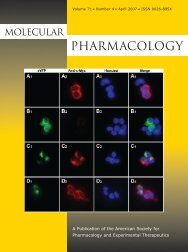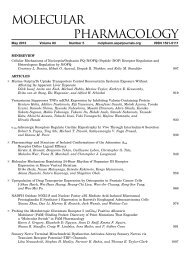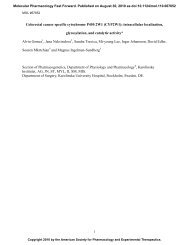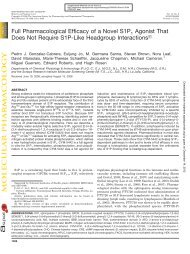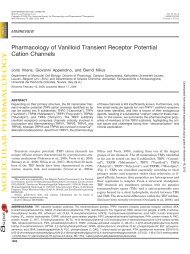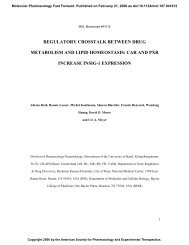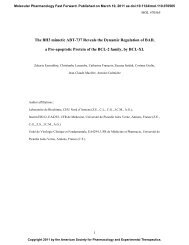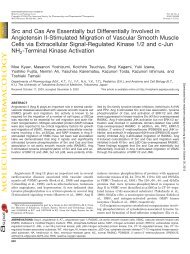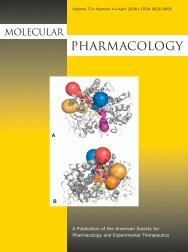Diclofenac Antagonizes Peroxisome Proliferator-Activated Receptor ...
Diclofenac Antagonizes Peroxisome Proliferator-Activated Receptor ...
Diclofenac Antagonizes Peroxisome Proliferator-Activated Receptor ...
You also want an ePaper? Increase the reach of your titles
YUMPU automatically turns print PDFs into web optimized ePapers that Google loves.
12 Adamson et al.<br />
fully when choosing compounds to be used for cancer chemoprevention<br />
studies.<br />
In summary, diclofenac has an affinity for PPAR 50 times<br />
greater than previously reported for other NSAIDs and is a<br />
partial agonist that can inhibit the action of the thiazolidinedione<br />
rosiglitazone in a receptor-dependent manner.<br />
Antagonism of PPAR signaling by diclofenac prevents adipocyte<br />
differentiation and alters the proliferation kinetics of<br />
a PPAR-dependent cancer cell line, releasing the cells from<br />
proliferation arrest.<br />
Acknowledgments<br />
We thank Helen Vosper and Andrew Morris for comments on the<br />
manuscript.<br />
References<br />
Anonymous (1999) A unified nomenclature system for the nuclear receptor superfamily<br />
[letter]. Cell 97:161–163.<br />
Brighty DW, Rosenberg M, Chen IS, and Ivey-Hoyle M (1991) Envelope proteins<br />
from clinical isolates of human immunodeficiency virus type 1 that are refractory<br />
to neutralization by soluble CD4 possess high affinity for the CD4 receptor. Proc<br />
Natl Acad Sci USA 88:7802–7805.<br />
Camp HS, Li O, Wise SC, Hong YH, Frankowski CL, Shen X, Vanbogelen R, and Leff<br />
T (2000) Differential activation of peroxisome proliferator-activated receptor- by<br />
troglitazone and rosiglitazone. Diabetes 49:539–547.<br />
Chang T-H and Szabo E (2000) Induction of differentiation and apoptosis by ligands<br />
of peroxisome proliferator-activated receptor in non-small cell lung cancer.<br />
Cancer Res 60:1129–1138.<br />
Cullen BR (1987) Use of eukaryotic expression technology in the functional analysis<br />
of cloned genes. Methods Enzymol 152:692–693.<br />
Demetri GD, Fletcher CD, Mueller E, Sarraf P, Naujoks R, Campbell N, Spiegelman<br />
BM, and Singer S (1999) Induction of solid tumor differentiation by the peroxisome<br />
proliferator-activated receptor-gamma ligand troglitazone in patients with liposarcoma.<br />
Proc Nat Acad Sci USA 96:3951–3956.<br />
DuBois RN, Gupta R, Brockman J, Reddy BS, Krakow SL, and Lazar MA (1998) The<br />
nuclear eicosanoid receptor, PPAR, is aberrantly expressed in colonic cancers.<br />
Carcinogenesis 19:49–53.<br />
Elder DJE, Halton DE, Hague A, and Paraskeva C (1997) Induction of apoptotic cell<br />
death in human colorectal carcinoma cell lines by a cyclooxygenase-2 (COX-2)-<br />
selective nonsteroidal anti-inflammatory drug: independence from COX-2 protein<br />
expression. Clin Cancer Res 3:1679–1683.<br />
Elder DJE and Paraskeva C (1998) COX-2 inhibitors for colorectal cancer. Nat Med<br />
4:392–393.<br />
English N, Hughes V, and Wolf CR (1996) Induction of cytochrome P-450 BM-3 (CYP<br />
102) by non-steroidal anti-inflammatory drugs in Bacillus megaterium. Biochem J<br />
316:279–283.<br />
Forman BM, Tontonoz P, Chen J, Brun RP, Spiegelman BM, and Evans RM (1995)<br />
15-Deoxy- 12,14 -prostaglandin J2 is a ligand for the adipocyte determination factor<br />
PPAR. Cell 83:803–812.<br />
Gelman L, Fruchart J-C, and Auwerx J (1999) An update on the mechanisms of<br />
action of the peroxisome proliferator-activated receptors (PPARs) and their roles<br />
in inflammation and cancer. Cell Mol Life Sci 55:932–943.<br />
Giardiello FM (1994) Sulindac and polyp regression. Cancer Metastasis Rev 13:279–<br />
283.<br />
Gilroy DW, Colville-Nash PR, Willis D, Chivers J, Paul-Clark MJ, and Willoughby<br />
DA (1999) Inducible cyclooxygenase may have anti-inflammatory properties. Nat<br />
Med 5:698–701.<br />
He TC, Chan TA, Vogelstein B, and Kinzler KW (1999) PPAR is an APC-regulated<br />
target of nonsteroidal anti-inflammatory drugs. Cell 99:335–345.<br />
Hisatake JI, Ikezoe T, Carey M, Holden S, Tomoyasu S, and Koeffler HP (2000)<br />
Down-regulation of prostate-specific antigen expression by ligands for peroxisome<br />
proliferator-activated receptor in human prostate cancer. Cancer Res 60:5494–<br />
5498.<br />
Jiang C, Ting AT, and Seed B (1998) PPAR- agonists inhibit production of monocyte<br />
inflammatory cytokines. Nature (Lond) 391:82–86.<br />
Kehrer JP, Biswal SS, La E, Thuillier P, Datta K, Fischer SM, and Vanden Heuvel<br />
JP (2001) Inhibition of peroxisome-proliferator-activated receptor (PPAR) by<br />
MK866. Biochem J 356:899–906.<br />
Landegren U (1984) Measurement of cell numbers by means of the endogenous<br />
enzyme hexosaminidase. Applications to detection of lymphokines and cell surface<br />
antigens. J Immunol Methods 67:379–388.<br />
Lehmann JM, Moore LB, Smith-Oliver TA, Wilkison WO, Willson TM, and Kliewer<br />
SA (1995) An antidiabetic thiazolidinedione is a high affinity ligand for peroxisome<br />
proliferator-activated receptor (PPAR). J Biol Chem 270:12953–56.<br />
Lehmann JM, Lenhard JM, Oliver BB, Ringold GM, and Kliewer SA (1997) <strong>Peroxisome</strong><br />
proliferator-activated receptors and are activated by indomethacin and<br />
other non-steroidal anti-inflammatory drugs. J Biol Chem 272:3406–3410.<br />
Lynch NR, Castes M, Astoin M, and Salomon JC (1978) Mechanism of inhibition of<br />
tumour growth by aspirin and indomethacin. Br J Cancer 38:503–512.<br />
Miles PDG, Barak Y, Weiman H, Evans RM, and Olefsky JM (2000) Improved<br />
insulin-sensitivity in mice heterozygous for PPAR- deficiency. J Clin Invest<br />
105:287–292.<br />
Mueller E, Sarraf P, Tontonoz P, Evans RM, Martin KJ, Zhang M, Fletcher C, Singer<br />
S, and Spiegelman BM (1998) Terminal differentiation of human breast cancer<br />
through PPAR. Mol Cell 1:465–470.<br />
Mueller E, Smith M, Sarraf P, Kroll T, Aiyer A, Kaufman DS, Oh W, Demetri G, Figg<br />
WD, Zhou XP, et al. (2000) Effects of ligand activation of peroxisome proliferatoractivated<br />
receptor in human prostate cancer. Proc Natl Acad Sci USA 97:10990–<br />
10995.<br />
Nuutinen LS, Laitinen JO, and Salomäki TE (1993) A risk-benefit appraisal of<br />
injectable NSAIDs in the management of postoperative pain. Drug Safety 9:380–<br />
393.<br />
Palmer CNA and Wolf CR (1998) cis-Parinaric acid is a ligand for the human<br />
peroxisome proliferator activated receptor gamma: development of a novel spectrophotometric<br />
assay for the discovery of PPARgamma ligands. FEBS Lett 431:<br />
476–480.<br />
Ramírez-Zacarías JL, Castro-Muñozledo F, and Kuri-Harcuch W (1992) Quantitation<br />
of adipose conversion and triglycerides by staining intracytoplasmic lipids<br />
with Oil red O. Histochemistry 97:493–497.<br />
Rao CV, Rivenson A, Simi B, Zang E, Kelloff G, Steele V, and Reddy BS (1995)<br />
Chemoprevention of colon carcinogenesis by sulindac, a nonsteroidal antiinflammatory<br />
agent. Cancer Res 55:1464–1472.<br />
Sarraf P, Mueller E, Jones D, King FJ, DeAngelo DJ, Partridge JB, Holden SA, Chen<br />
LB, Singer S, Fletcher C, et al (1998) Differentiation and reversal of malignant<br />
changes in colon cancer through PPAR. Nat Med 4:1046–1052.<br />
Sarraf P, Mueller E, Smith WM, Wright HM, Kum JB, Aaltonen LA, de la Chapelle<br />
A, Spiegelman BM, Eng C (1999) Loss-of-function mutations in PPAR associated<br />
with human colon cancer. Mol Cell 3:799–804.<br />
Scholer DW, Ku EC, Boettcher I, and Schweizer A (1986) Pharmacology of diclofenac<br />
sodium. Am J Med 80(Suppl. 4B):34–38.<br />
Schoonjans K and Auwerx J (2000) Thiazolidinediones an update. Lancet 355:1008–<br />
1010.<br />
Turner D and Berkel HJ (1993) Nonsteroidal anti-inflammatory drugs for the prevention<br />
of colon cancer. Can Med Assoc J 149:595–602.<br />
Vamecq J and Latruffe N (1999) Medical significance of peroxisome proliferatoractivated<br />
receptors. Lancet 354:141–148.<br />
Willis JV, Kendall MJ, and Jack DB (1981) The influence of food on the absorption<br />
of diclofenac after single and multiple oral doses. Eur J Clin Pharmacol 19:33–37.<br />
Address correspondence to: Dr. Colin N. A. Palmer, ICRF Molecular Pharmacology<br />
Unit, Biomedical Research Center, Level 5, Ninewells Hospital,<br />
Dundee, DD1 9SY, UK. E-mail: palmerc@icrf.icnet.uk




